
BIOS and Overclocking …
Get fast to the right UEFI settings …
BIOS and Overclocking
UEFI BIOS Update
ASRock X99 WS-E overclocking
ASRock X99 WS-E memory settings
ASRock X99 WS-E voltage settings
Overclock even easier
BIOS undervolting
Fan control
Energy consumption
BIOS and overclocking …
Let us continue with the BIOS / UEFI Setup options and the UEFI overclocking. By pressing F2 or Del during PC boot, you get access to the UEFI Setup.
The ASRock X99 WS-E10G UEFI has a graphical interface that allows intuitive operation with the mouse, or can be operated still as usual with a keyboard.
On the first BIOS page you can see the UEFI version, installed CPU, installed DDR4 memory, language selection, and My Favorite menu item:
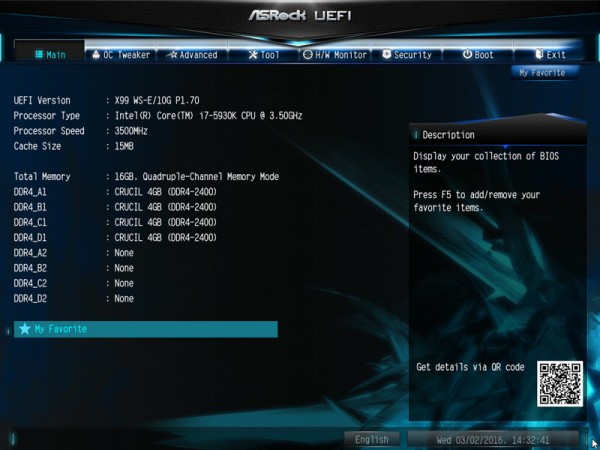
The My Favorite feature is very useful, because you can add here often needed menu items. You start with a blank page – incidentally it’s also blank after a BIOS update. Simply select the desired menu item, then press F5 and the feature is contained in the my favorite overview page.
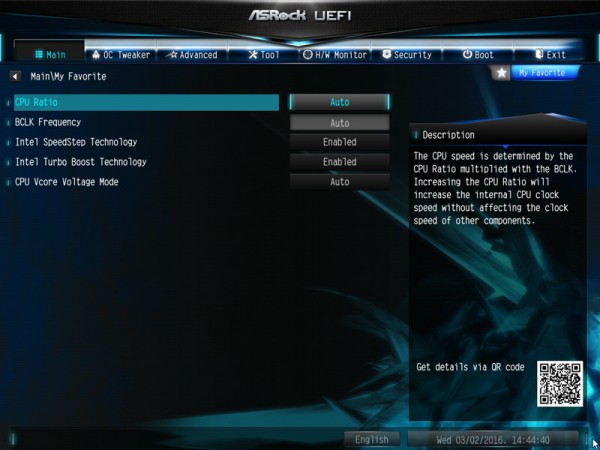
On the entry page you can also adjust the time and date, which is now also graphically selectable in the UEFI.
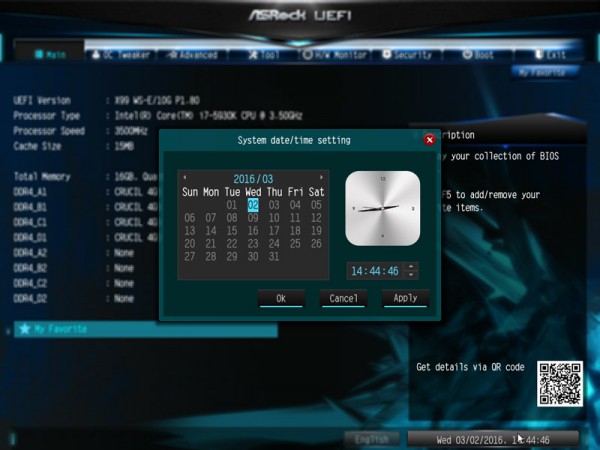
The X99 motherboard has a selection to view the UEFI in Full HD and also offers the Active Page on Entry selection, where you can decide which UEFI page you want to see when you enter the UEFI Setup. This is very helpful mainly for overclocking, since one have to enter the second OC Tweaker menu very often to find the best OC settings. Or you just add all necessary points to the My Favorite overview and start directly to the My Favorite overview page. At the ASRock X99 WS-E/10G you find the Active Page on Entry option and the Full HD UEFI selection now in Advanced.
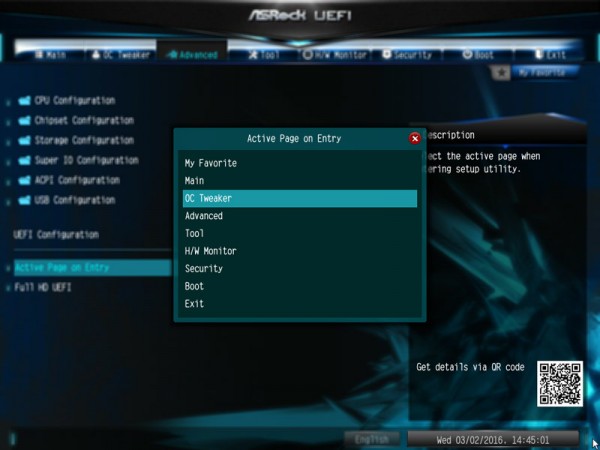
UEFI BIOS Update …
Before we begin with the UEFI settings, we first update the UEFI BIOS to the latest version. To flash the UEFI update ASRock offers some possibilities, e.g. the very simple Instant Flash or the ASRock Internet Flash with a direct connection to the Internet.
By the so-called ASRock Instant Flash option in the tool screen or via F6 during PC start you get into the ASRock Instant Flash utility.
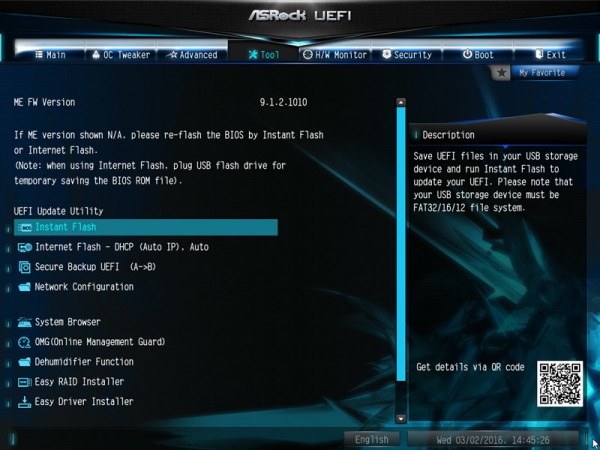
Now you can easily flash a previously downloaded ASRock BIOS without a boot CD or similar by simply starting the ASRock Instant Flash utility. Just select the BIOS Flash ROM from the desired drive, like an USB stick and even without a boot medium it is flashed and available after a restart. The board is supplied with the BIOS P1.70. At testing date, the UEFI BIOS version P1.80 was available as latest download, which we updated of course immediately.

Then you confirm the UEFI update.
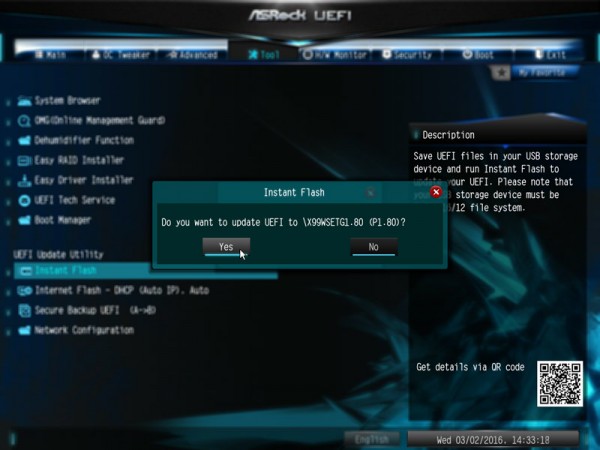
And the new UEFI will be installed.
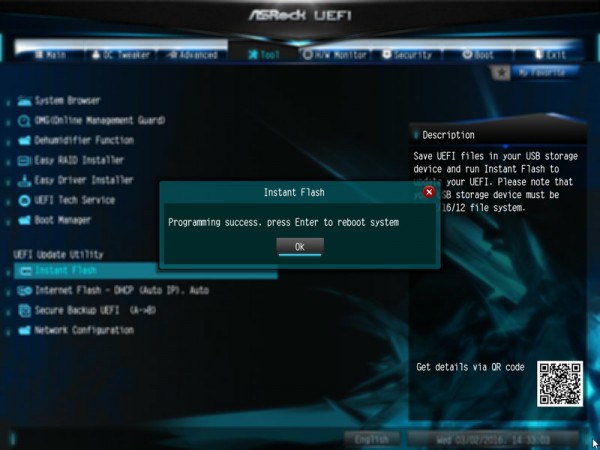
The new UEFI version is available after a restart and can be checked on the entry page.
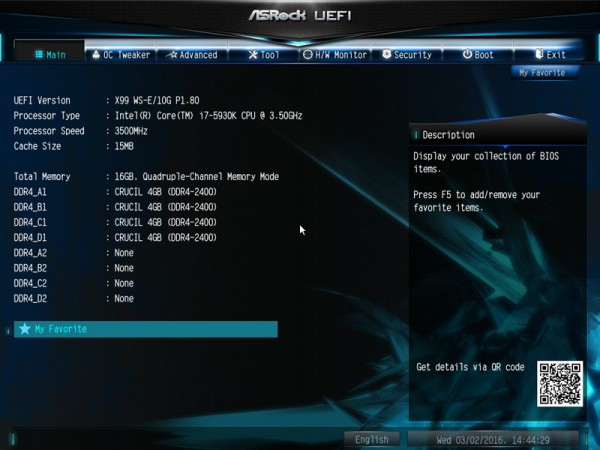
If you need technical UEFI support, you can now even contact the ASRock Tech Service over the UEFI setup and a network connection.
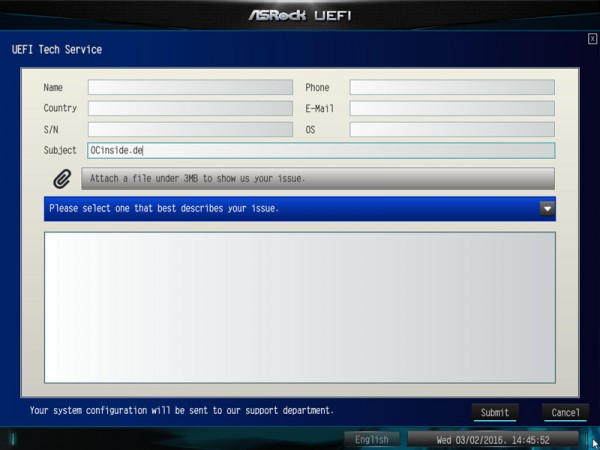
On the tool page, you can find by the way a system browser view, where you can graphically see all installed components.
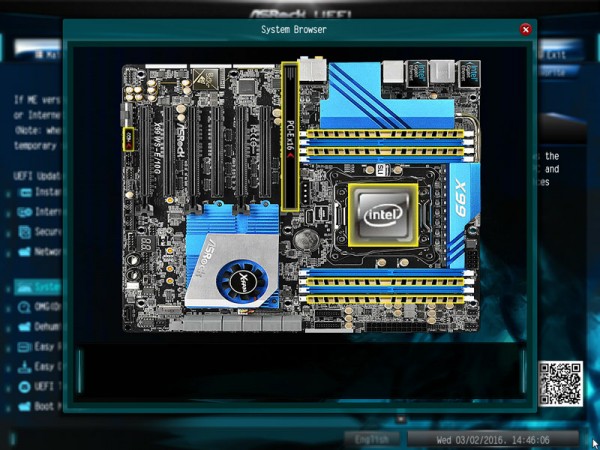
By a click on the I/O panel you can see the installed devices of each port.
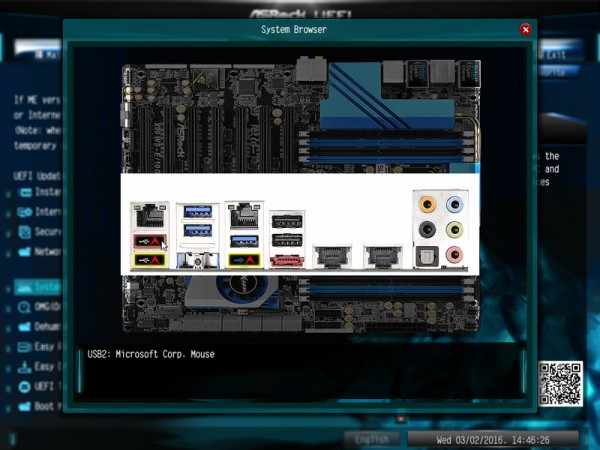
In addition, there is also the OMG – Online Management Guard, with which you can define the times and days for the Internet access. This is for example useful for parents who like to specify a fixed Internet time for their children and want to block access with a password secure in UEFI BIOS, or for companies that allow Internet access for their employees only during lunch or after regular working hours.
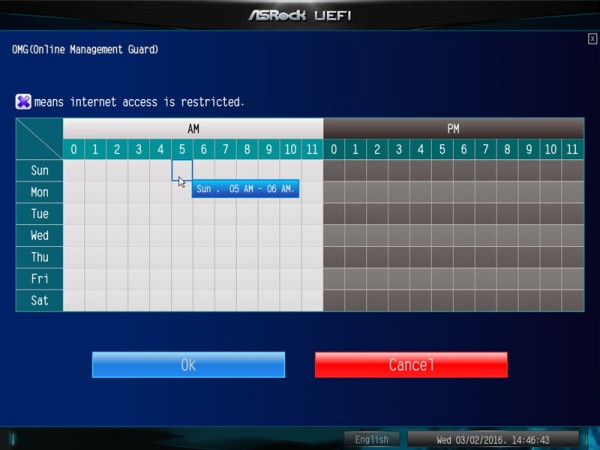
ASRock X99 WS-E/10G overclocking …
ASRock split the settings in CPU Configuration, DRAM Configuration, FIVR Configuration and Voltage Configuration.
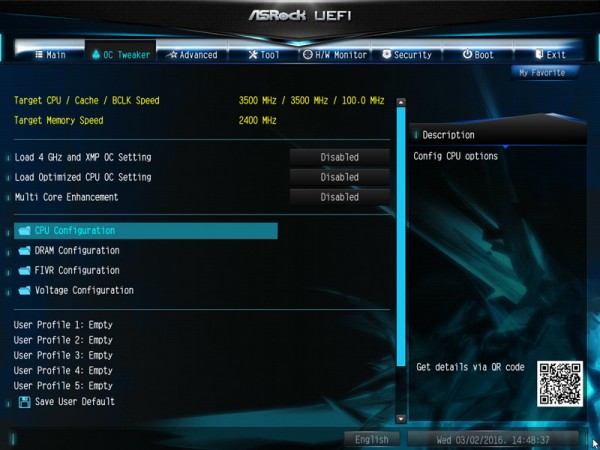
A look at the options under CPU configuration shows many OC options for the Intel LGA2011-3 CPU overclocking.
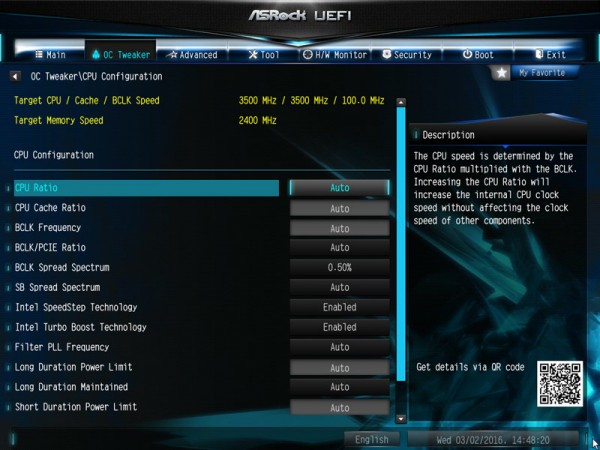
One can set the BCLK/PCIE frequency in this menu from 96 MHz to 300 MHz. This frequency is very important for a lot of frequency values also with Intel LGA2011-3 processors, which can get quickly too high. For this reason, you should carefully increase the BCLK host clock and also adjust the BCLK ratio to 125 MHz, 167 MHz or even higher.
In our tests the board at 1.67 BCLK ratio could be stable overclocked to 170 MHz BCLK!
The Intel “K” CPUs have an unlocked multiplier, so one can overclock the CPU frequency very extensively over the CPU multiplier. With a 5930K CPU (default clock 3500 MHz with a CPU ratio of 35x), the ASRock X99 WS-E/10G motherboard offered a multiplier range from 12x to 120x.
ASRock X99 WS-E/10G memory settings …
Thanks to XMP support, XMP memory modules can be set correctly with one mouse click in the UEFI by selecting the desired profile in the DRAM configuration. In the DRAM configuration menu you will find among others the selection, whether to the DDR4 reference clock 100 MHz or 133 MHz and how high you like to adjust the DDR4 RAM voltage.
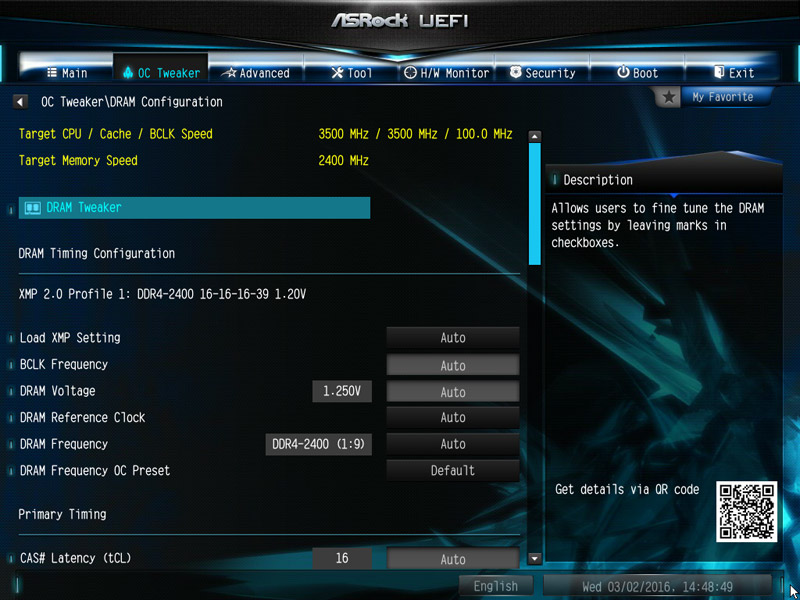
For DDR4 memory, there are settings like e.g. the memory frequency from DDR4-800 up to DDR4-2666. Here you see the DDR4 frequency selection up to DDR4-2666:
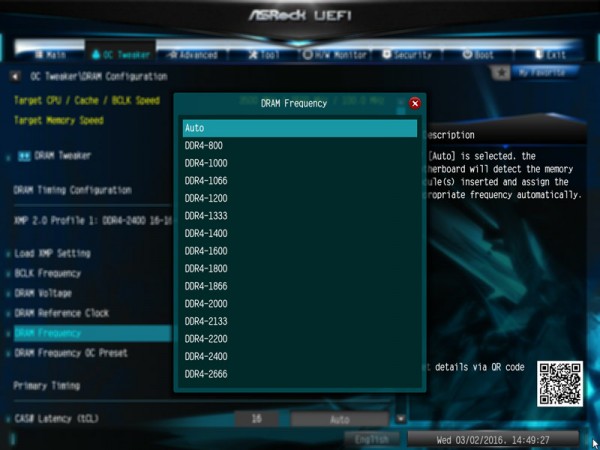
ASRock has more very special to offer, because higher DRAM settings can be easily selected by the DRAM Frequency OC Preset values. With this DDR4 OC preset it is possible for example to overclock to DDR4-3500 by automatic BCLK increasing:
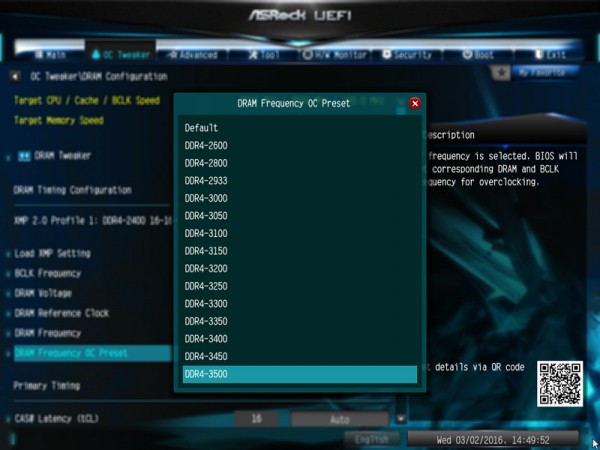
With manual BCLK overclocking significantly higher memory clock rates are possible. The frequency of all memory modules is calculated and displayed after changing the reference clock to make it much easier adjusting to the right RAM frequency.
Optionally you can manually adjust all DDR4 timings:
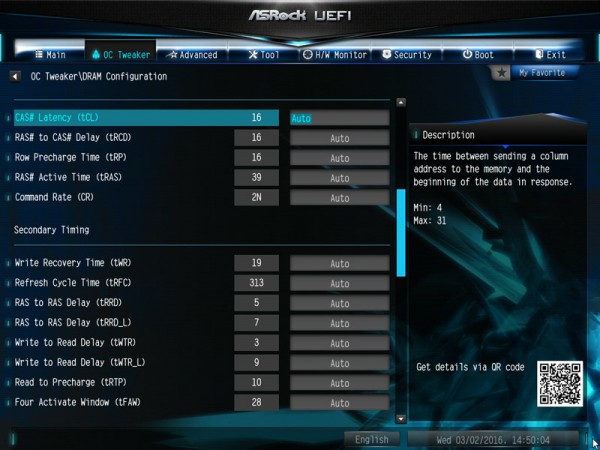
Furthermore the ASRock X99 WS-E offers e.g. an overview of all SPD and XMP values to select them directly in the DRAM Tweaker menu.
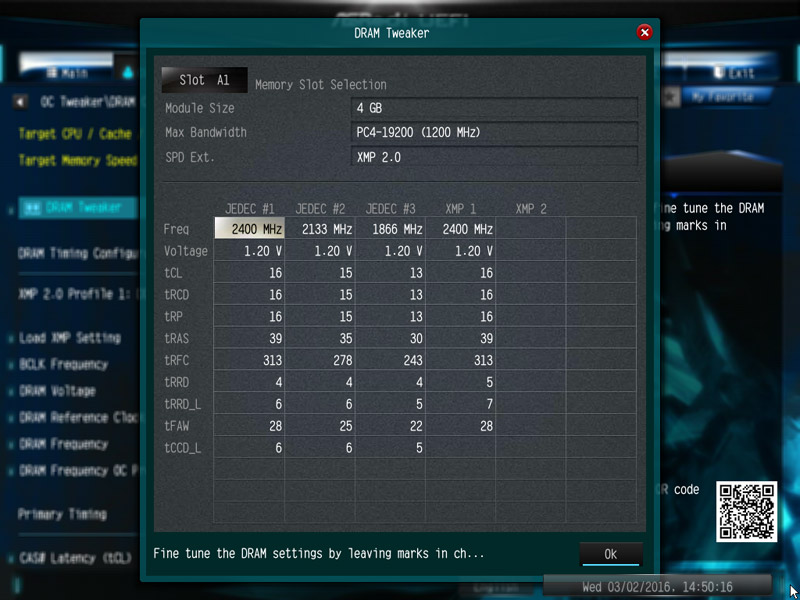
If you have memory modules with XMP profile, you can load the values from the XMP EEPROM here.
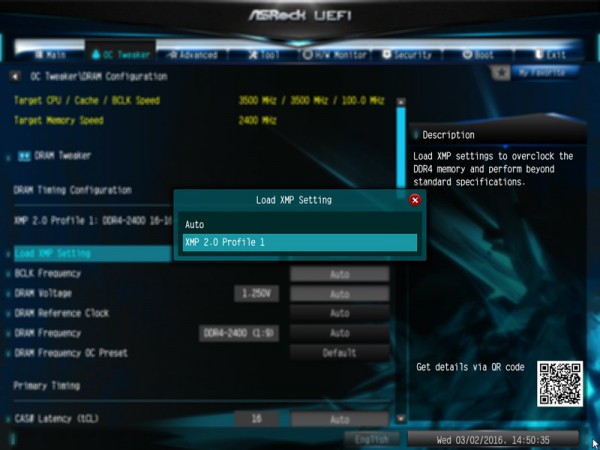
ASRock X99 WS-E/10G voltage settings …
Now we come to the voltage settings that can be adjusted in the UEFI.
For X99 the voltage settings are separated in FIVR Configuration and Voltage Configuration.
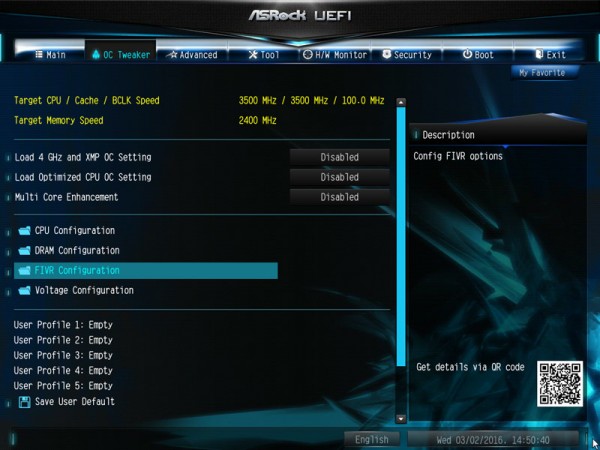
Here are the settings for the FIVR configuration:
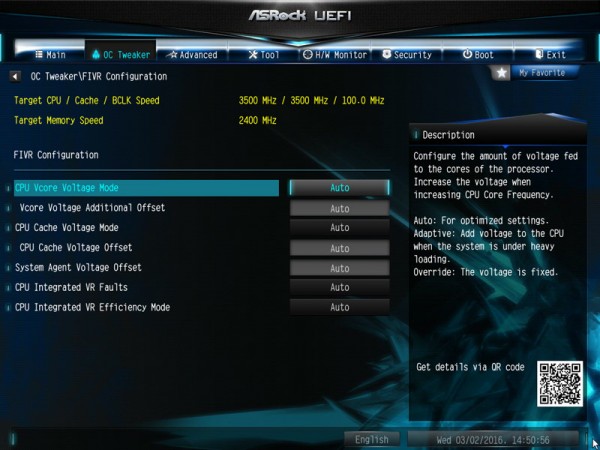
Alle weiteren Spannungen befinden sich unter Voltage Configuration.
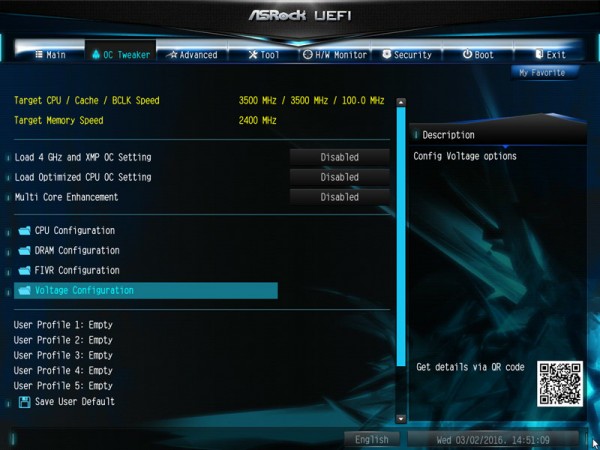
The motherboard has many voltage settings, like for example a VCore selection with the Intel Core i7-5930K Test CPU from 0.800 Volt up to 2.000 Volt and -0.500V to +0.500V offset, CPU Cache Voltage from 0.800 Volt to 2.000 Volt and -0.500V to +0.500V Offset, CPU Input Voltage from 1.200V to 2.300V and -0.600V to +0.400V Offset, CPU IO Voltage from 0.900 to 1.500 Volt, PCH (Chipset) voltage from 0.900 to 1.500 Volt, PCH PLL Voltage from 1.200 to 1.800 Volt, ME Voltage 0.900 to 1.500 Volt, System Agent Voltage Offset from -0.300 to +0.600 Volt, Primary Plane Current Limit, Short Duration Power Limit, Long Duration Power Limit, CPU Load Line Calibration from 1 to 5, DRAM Activation Power Supply from 2.400V to 3.000V and more voltage boost settings to offer more room for detailed overclocking.
The DDR4 voltage could be increased as seen above, between 1.000 and 1.800 Volt, which should be enough DDR4 memory voltage for high overclocking or low undervolting.
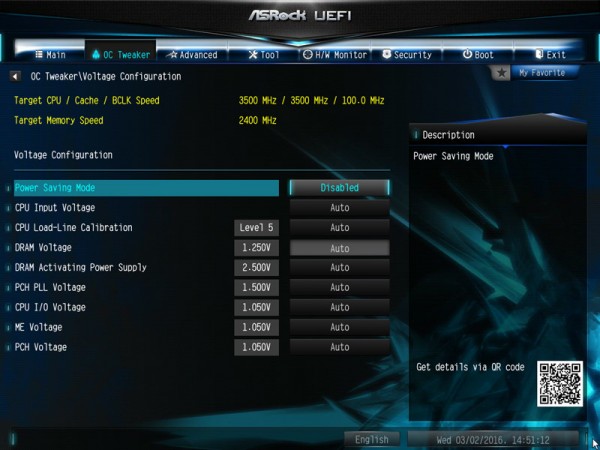
Overclock even easier …
If you do not like to get deeper inside of overclocking, you can overclock either by the Load 4 GHz and XMP OC Setting or by the Load Optimized CPU OC Settings, to try overclocking with predefined OC settings. It can increase the system performance automatically by overclocking in different Turbo steps – at least with some luck and if it is possible with your processor. Simply select the desired Optimized CPU OC setting, then some components and the CPU are overclocked, e.g. to Turbo 4.0 GHz, Turbo 4.2 GHz, Turbo 4.4 GHz or Turbo 4.6 GHz – overclocking could not be easier !
Here you can see the Load Optimized CPU OC Settings for the Intel 5930K CPU:
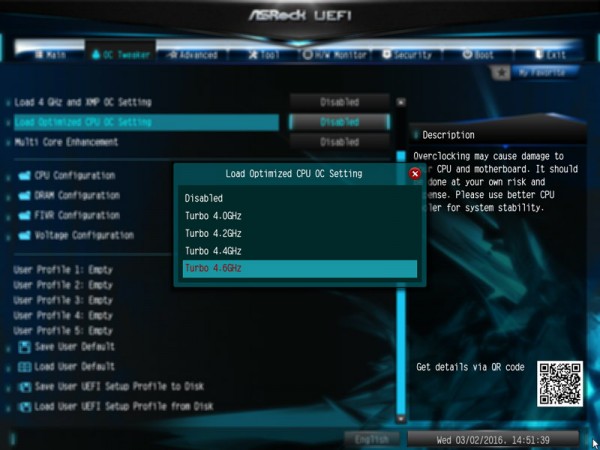
Highest overclocking should set manually for each value, to be able adjusting all values in detail for the installed hardware. We give you overclocking help in our PC Forum.
Once the desired settings are found, you can save up to five different OC Tweaker BIOS settings with names in the UEFI. For example, you can save balanced BIOS settings, overclocking settings and undervolting settings in an user profile of the UEFI to load them very quickly at any time.
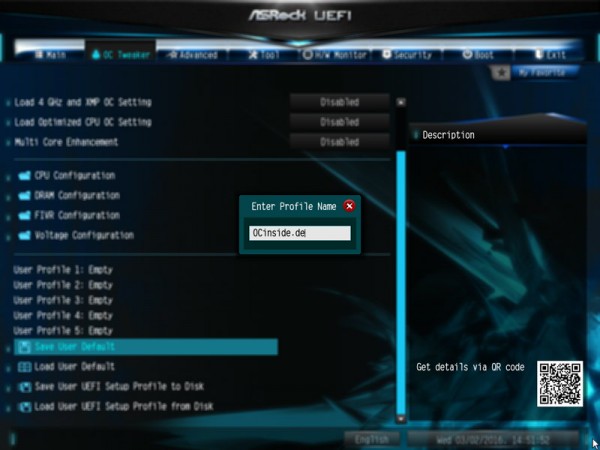
Also interesting is the new “Save User UEFI Setup Profile to Disk” option. Just click it to save your own UEFI settings on the hard drive or an USB stick, to have a backup of all values for example, after an UEFI update.
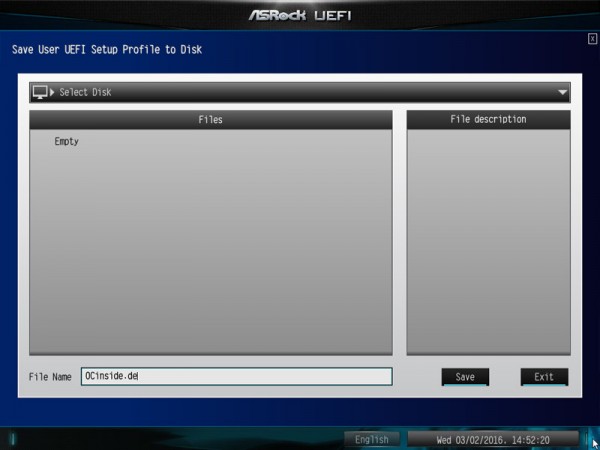
The boot failure guard was also tested and started the PC even at too high overclocking settings without Clear CMOS at default frequencies. ASRock offers the “Boot Failure Guard Count” option to setup, how often the board should boot with incorrect settings before it automatically reduces the frequencies. If it accidentally succeeds that the PC fails to boot, you can also press the Clear CMOS button and the stored values in the user profiles fortunately remain to load them quickly.
BIOS Undervolting …
The downclocking or underclocking is also tested in this review. It was possible to lower the Intel Core-i7-5930K CPU multiplier over the BIOS to 12x to underclock the processor with 100 MHz BCLK to approx. 1200 MHz. Of course, underclocking is like overclocking outside of the manufacturers specification, so it is necessary to have some luck. ASRock gives several options for easy PC underclocking / downclocking.
Of course there are more UEFI settings like CPU, Chipset, Storage, Super IO, ACPI and USB Configuration setup.
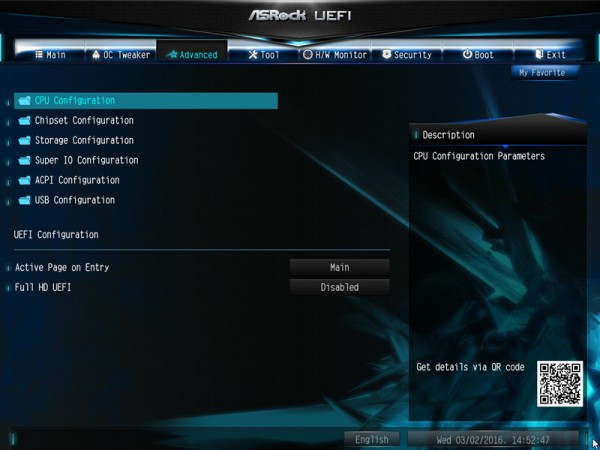
If you want to save energy consumption of the Intel Core i7 PC, you should check all settings in the CPU configuration menu under Advanced.
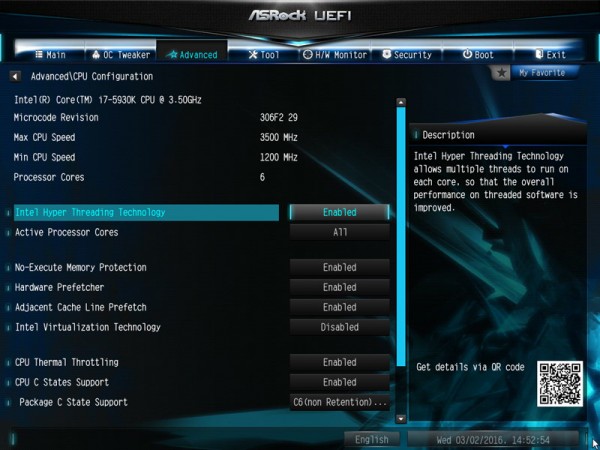
But also the other settings in Advanced Chipset Configuration are very interesting.
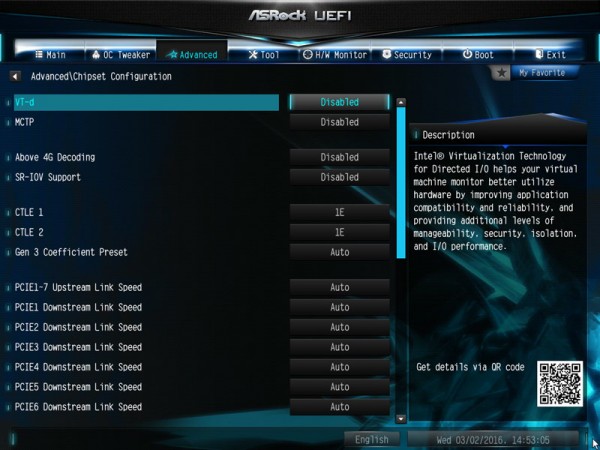
There is also the option if you would like to enable the two Intel X540 LAN ports – of course!
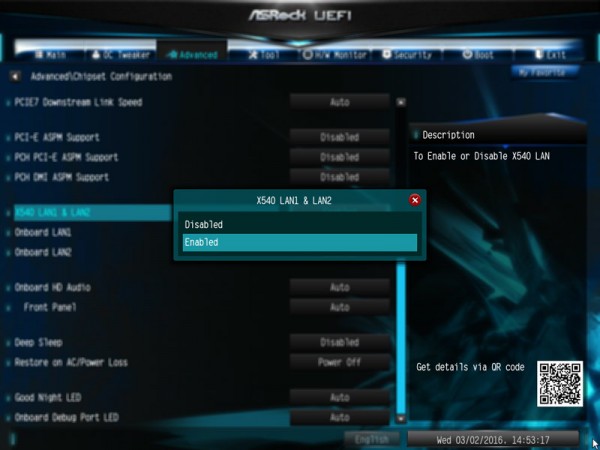
Fan control …
The UEFI Setup of the passive cooled X99 WS-E/10G motherboard offers extensive temperature fan control options for a 4-pin or 3-pin CPU fan, the 4-pin chassis fan 1, the 3-pin chassis fan 2 and the 3-pin chassis fan 3.
The settings for the fan controller can be found in H/W Monitor directly below the temperature und voltage display.
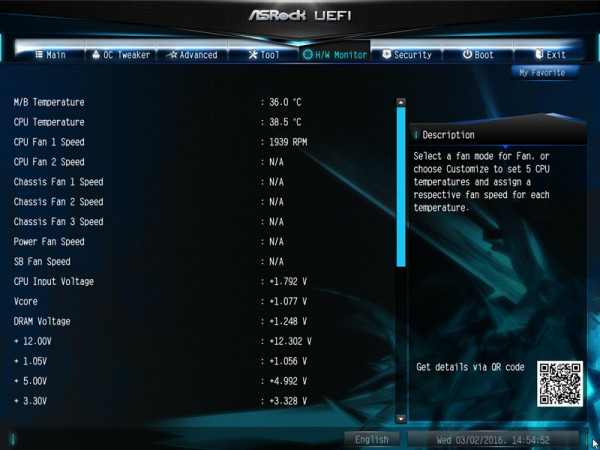
You have the choice between Customize, Silent, Standard, Performance and Full Speed.
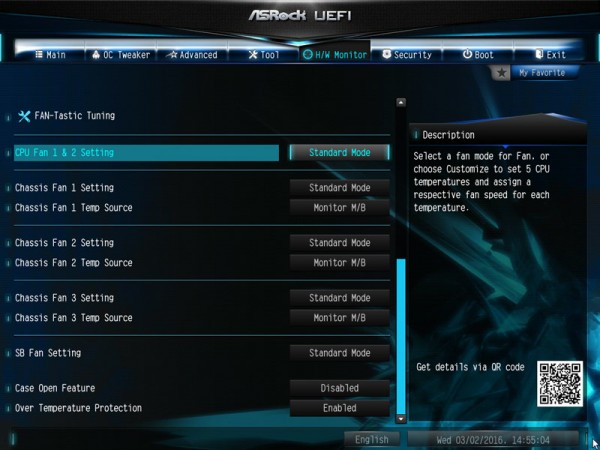
Here you can see the settings of the fan controller.
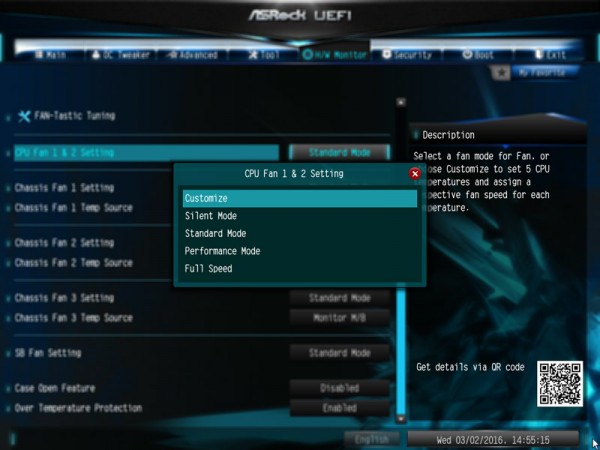
In Customize mode are several temperature steps to assign a certain fan speed.
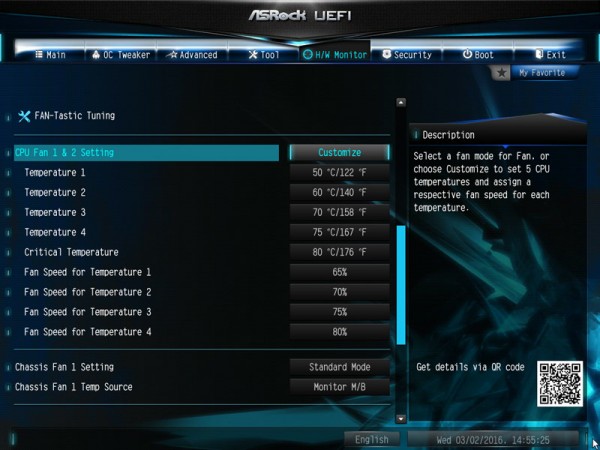
Since the announcement of X99 motherboards, ASRock has even implemented a graphical interface in the UEFI setup for controlling the fans. You can find the FAN-Tastic Tuning menu also in the H/W monitor and thus can make all the settings very clearly. Simply select the respective fan connector on the left and select the mode on the right side – e.g. Performance.
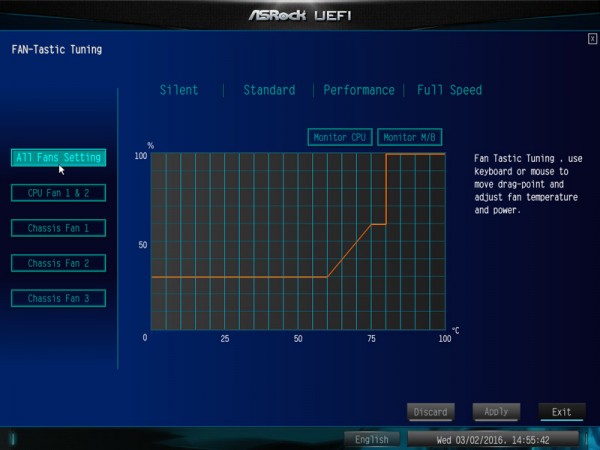
In Customize mode, you can set all values directly in the chart and save.
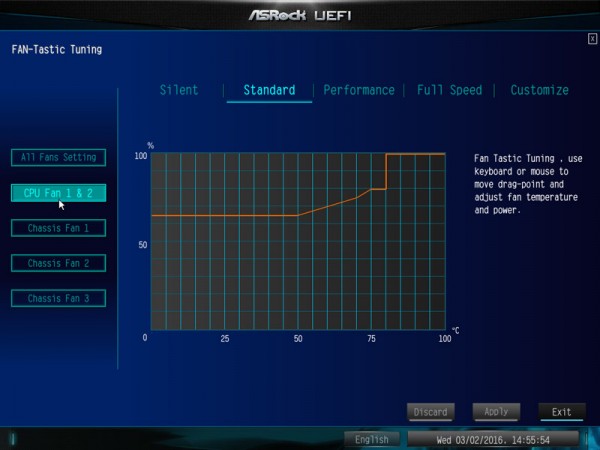
For the chassis fan connectors you can even select, which source you want to use for temperature measurement: Monitor CPU or Monitor Motherboard. Then click on apply and save the values.
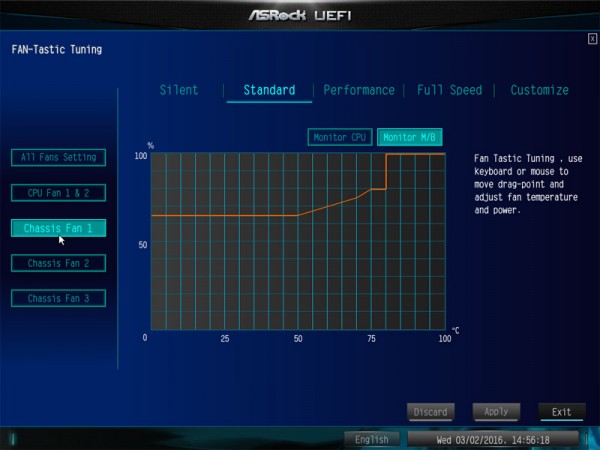
You can usually get along without an expensive Fan Controller, because the fans are controlled with this fan control based on the CPU or the motherboard temperature.
Energy consumption …
The power consumption will vary depending upon the hardware and upon the PC load. The current consumption of the test PC with Intel Core i7-5930K CPU, 4x 4GB DDR4-2400 memory, hard disk drive and Cooler Master Silent Pro M 600W test PSU without overclocking depending upon load:
– With MSI Radeon R9 280 video card the X99 PC power consumption was between 87.5W idle and 324.3W load.
Thus, consumption with 10GBit LAN and active fan is approx. 25-35 Watt higher than the previously tested X99 motherboards.
An ASRock X99 Extreme6 motherboard with an Intel Core i7-5930K LGA2011-3 CPU and 4x 4GB DDR4 had the following power consumption:
– With MSI Radeon R9 280 between 60.5W idle and 290.4W load.
An ASRock Z170 Extreme6 Intel Z170 motherboard with an Intel Core i5-6600K LGA1151 CPU had the following power consumption:
– With MSI Radeon R9 280 graphics card the entire power consumption was 50.5W idle and full load 259.1W.
– With integrated Intel HD Graphics GPU 530 the total consumption was 36.0W idle and 70.7 Watt at full load.
An ASRock Z97 Extreme6 Intel Z97 motherboard with an Intel Core i5-4670K CPU had the following power consumption:
– With MSI Radeon R9 280 between 53.1W idle and 270.7W load.
– With Sapphire HD6870 graphics card the entire power consumption was 55.8W idle and 219.5W full load.
– With integrated Intel HD Graphics 4600 GPU the total consumption was 33.5W idle and 94.5 Watt full load.
An ASRock Fatal1ty FM2A88X+ Killer AMD Socket FM2+ motherboard with an AMD A10-7850K Kaveri APU had the following PC energy consumption:
– With Sapphire HD6870 between 56.3W idle and 233.5 Watt full load.
– With internal AMD Radeon R7 GPU between 30.2W idle and 118.8 Watt full load.
An ASRock FM2A85X-ITX AMD Socket FM2 motherboard with an AMD A10-5800K Trinity APU had the following power consumption:
– With Sapphire HD6870 graphics card from 52.9W to 221.0 Watt.
– With internal AMD Radeon HD7660D GPU 29.4W idle and 120.4 Watt full load.
ASRock X99 WS-E/10G 10GBit LAN Benchmark results …

